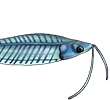Li, L., Deng, L., Li, J., Li, T., Chen, P., Luo, W., & Du, Z. Gill structure and respiratory ability of Euchiloglanis kishinouyei (Osteichthyes: Siluriformes: Sisoridae). Journal of Fish Biology. First published 31 August 2023.
https://doi.org/10.1111/jfb.15548
https://onlinelibrary.wiley.com/doi/abs ... /jfb.15548
Key words: E. kishinouyei; gill microstructure; espiratory ability; scanning electron microscopy (SEM)HighlightsAbstract
- First investigation of the microstructure of the gills of glyptosternoid fishes by scanning electron microscopy.
- The gills of E. kishinouyei showed an overall trend of regression, with five pairs of gill arches in each gill cavity. The adjacent gill filaments had large gaps, and the gill lamellae were thick.
- The relatively large oxygen consumption and intolerance to hypoxia of E. kishinouyei was associated with the long-term life in torrent environment, implying that the accessory respiratory organs (mainly the skin) compensate for oxygen intake when gill respiration was inadequate.
Glyptosternoid fishes are distributed in the torrent environment of alpine canyons, where they often leave the water to climb on rocky cliffs. As one of the most primitive species of glyptosternoid fishes, was examined in the current study to analyze its gill microstructure and respiratory ability. We first found that the oxygen consumption rate was relatively high and negatively correlated with body mass, and that the average oxygen consumption at night was higher than during the day. The asphyxiation point of E. kishinouyei (5.05 ± 0.22 g) was about 1.93 mg/L. Subsequently, the surface morphology, gross gill tissue structure and ultra-microstructure of gill lamellae were investigated by optical microscopy and scanning electron microscopy. The gills showed an overall trend of regression, with five pairs of gill arches in each gill cavity. The adjacent gill filaments were with large gaps, and the gill lamellae were thick. The gill filaments were closely arranged on the gill arches, their folded respiratory surface was highly vascularized with no tiny crest, while there were obvious tiny crests, grooves, pits, and pores on the non-respiratory surface. The gill lamellae were closely embedded on both sides of gill filaments, which were composed of flat epithelial cells, basement membrane, pillar cells and mucous cells. The gill total respiratory area correlated positively with body mass and length, while the gill relative respiratory area correlated negatively with body mass. We comprehensively analyzed the gill microstructure and respiratory capacity of E. kishinouyei, to provide fundamental data for the adaptive evolution of the gill structures of bimodally respiring fishes and offer insights into further study on the accessory air-breathing function of skin.






